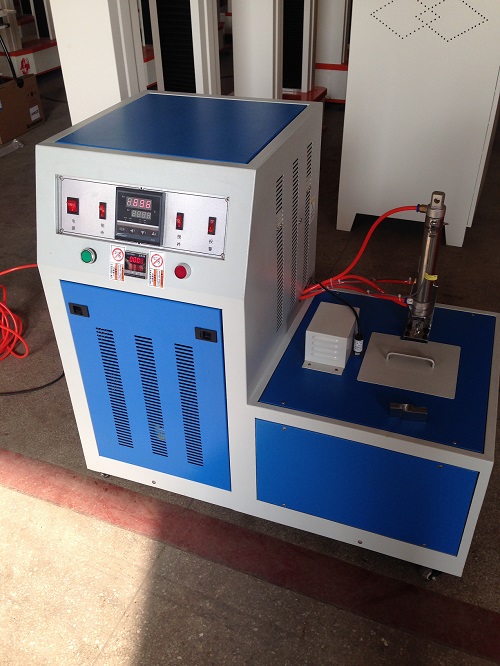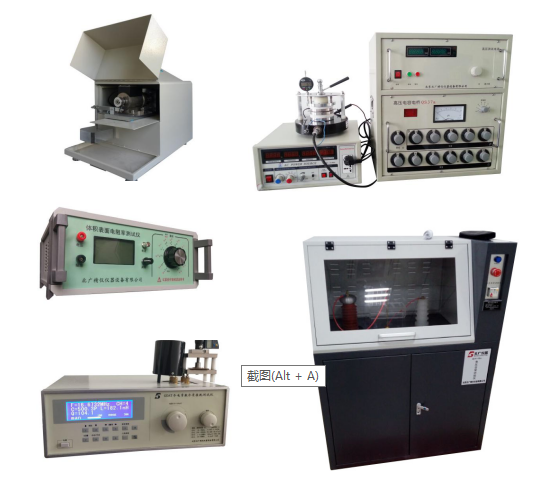
塑料低温脆性冲击试验机 适用行业:
可以用来考核和确定电工、电子、汽车电器、材料等产品,在低温环境条件下贮存和使用的适应性,适用于学校,工厂,军工,研位,等单位。
塑料低温脆性冲击试验机 结构原理
A、本设备由制冷压缩机主机体、加热装置、电子控制箱、冷却槽、冷却介质循环系统、自动报警装置等部分组成。启动制冷开关后,压缩机开始工作,制冷系统进入正式工作状态。制冷压缩机连续不断的工作,当接近设定温度时,冷却槽中的加热装置开始按比例提供热量,用以平衡制冷系统产生的多余冷量,以达到恒温的目的。搅拌可使冷却槽内的冷却介质不断循环,使温度均匀一致。
B、试样夹持器
试样一边夹持4个试样(橡胶类),另一边夹持15个试样(塑料类)。
C、冲击装置
冲击装置由冲击锤和自锁机构组成。
D、冲击器
冲击头半径为1.6?0.1mm;
冲击时,冲击头和试样夹持器之间间隙为6.4?0.3mm;
冲击头的中心线与试样夹持器之间的距离为8?0.3mm。
技术参数:
A. 控温范围:室温-70℃(室温≤25℃)
B. 恒温精度:?0.3℃
C. 降温速度:0℃~﹣30℃ 约2.5℃/min
D. ﹣30℃~﹣40℃ 约2.5℃/min
E. ﹣40℃~﹣70℃ 约2.0℃/min
F. 最大外形尺寸:900?500?800mm(长?宽?高)
G. 工作室有效工作空间:280?170?120mm(长?宽?高)
H. 可装试样数量:1
I. 数字计时器数字计时器:0秒-99分钟,分辨率1秒
J. 冷却介质:乙醇或其他不冻液
K. 搅拌电机:8W
L. 工作电源:220V--240V,50Hz,1.5kW
M. 工作温度:≤25℃
注意事项
1在试验过程中不能切断冷却循环,否则会产生不制冷的效果。
2气缸压力在出厂前已调节好,不能任意变动。
试验报告
A本标准名称或编号
B样品的详细说明及其来源
C使用的传热介质、致冷剂或其他降温方式
D程序A:脆性温度和试样破坏现象
E程序B:规定的试验温度和试验结果
试验结果与处理
程序A
1、试样出现破坏的最高温度,就是该试样的脆性温度。
2、温度值应精确到1度。
程序B
如果一组试样中没有任何1个试样破坏,则试验结果为无破坏。如果一组试样中有2个或2个以上试样发生破坏,则试验结果为破坏。如果一组试样中只有一个试样发生破坏,则再次取3个新的完好试样测试,3个试样均未发生破坏则试验结果为无破坏;否则试验结果为破坏。
传热介质
在试验温度下,能保持流动,对试样无附加影响的液体均可作传热介质。这类传热介质通常使用乙醇,此外还有丙酮、硅氧烷等。
致冷剂
可根据需要选用干冰或液氮。
注:也可采用其他降温方式。
Applicable industries:
It can be used to assess and determine the adaptability of products such as electricians, electronics, automotive appliances, materials, etc. to storage and use in low-temperature environmental conditions, suitable for schools, factories, military industries, research institutes, and other units.
Structural Principles
A. This equipment consists of a refrigeration compressor main body, a heating device, an electronic control box, a cooling tank, a cooling medium circulation system, an automatic alarm device, and other parts. After starting the refrigeration switch, the compressor starts working and the refrigeration system enters the official working state. The refrigeration compressor operates continuously, and as it approaches the set temperature, the heating device in the cooling tank begins to provide heat proportionally to balance the excess cooling generated by the refrigeration system and achieve constant temperature. Stirring can continuously circulate the cooling medium in the cooling tank, ensuring a uniform and consistent temperature.
B. Sample holder
One side of the sample holds 4 samples (rubber type), and the other side holds 15 samples (plastic type).
C. Impact device
The impact device consists of an impact hammer and a self-locking mechanism.
D. Impactor
The radius of the impact head is 1.6 ? 0.1mm;
During impact, the gap between the impact head and the sample holder is 6.4 ? 0.3mm;
The distance between the centerline of the impact head and the specimen holder is 8 ? 0.3mm.
Technical parameters:
A. Temperature control range: room temperature -70 ℃ (room temperature ≤ 25 ℃)
B. Constant temperature accuracy: ? 0.3 ℃
C. Cooling rate: 0 ℃~-30 ℃, about 2.5 ℃/min
D. -30 ℃~-40 ℃, about 2.5 ℃/min
E. -40 ℃~-70 ℃, about 2.0 ℃/min
F. Maximum external dimensions: 900 x 500 x 800mm (length x width x height)
G. Effective workspace of the studio: 280 x 170 x 120mm (length x width x height)
H. Number of samples that can be loaded: 1
I. Digital timer: 0-99 minutes, resolution of 1 second
J. Cooling medium: ethanol or other non freezing liquids
K. Mixing motor: 8W
L. Working power supply: 220V-240V, 50Hz, 1.5kW
M. Working temperature: ≤ 25 ℃
Precautions
During the experiment, the cooling cycle should not be cut off, otherwise it will result in a non cooling effect.
The pressure of cylinder 2 has been adjusted before leaving the factory and cannot be changed arbitrarily.
Test report
The name or number of this standard A
Detailed description and source of sample B
The heat transfer medium, refrigerant or other cooling methods used by C
D program A: brittle temperature and specimen failure phenomenon
Procedure B: Prescribed test temperature and test results
Test results and handling
Program A
1. The highest temperature at which the specimen fails is the brittle temperature of the specimen.
2. The temperature value should be accurate to 1 degree.
Program B
If none of the samples in a group are damaged, the test result is no damage. If two or more samples in a group are damaged, the test result is considered as failure. If only one sample in a group is damaged, take three new intact samples for testing. If none of the three samples are damaged, the test result is no damage; Otherwise, the test result will be considered as destruction.
Heat transfer medium
At the test temperature, liquids that can maintain flow and have no additional impact on the sample can be used as heat transfer media. This type of heat transfer medium usually uses ethanol, in addition to acetone, siloxane, etc.
Refrigerant
Dry ice or liquid nitrogen can be selected as needed.
Note: Other cooling methods can also be used.
业务咨询:932174181 媒体合作:2279387437 24小时服务热线:15136468001 盘古机械网 - 全面、科学的机械行业免费发布信息网站 Copyright 2017 PGJXO.COM 豫ICP备12019803号